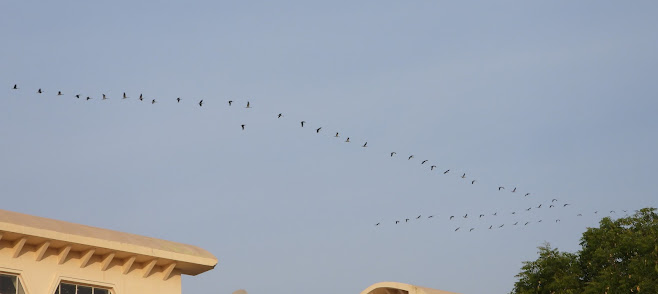FLIGHT OF CRANES
LT COL NOEL ELLIS
13/XI/2021
The other day I got an invitation from an acquaintance to photograph the abundant bird life around her school. Adjacent to that school is a huge pond where migratory birds congregate every year. It is time for them to come. Last year due to unavoidable circumstances I had missed them but this year, I shall not miss the opportunity to see them live.
It happened so that I had just finished breakfast and browsing messages on the mobile. There was a distinct and familiar chatter in the air. I was sure these were migratory cranes. They call each other at regular intervals. I rushed to pick the camera and scooted to confirm if what I was thinking was true.
It definitely was. Over the years my ears can recognise a few ‘bird sounds’. There were more than a hundred in this flock. There was no time to check the camera settings. It was just a click followed by lots of clicks. Mind you, they are fast. Before one realised one could just hear their calls as they faded in a distance. They have various vocalisations including honks, purrs, and trills. I am sure every sound means something, not like humans who can blow their car horn for no reason.
It was a magnificent fly past, a real treat to the eye. My mind started working on what they were communicating to each other. Was it the ‘ginti’ , the counting drill, which we used to practice while patrolling? Or was it a mom disciplining a naughty crane who fell out of line.
While Patrolling, the last soldier would tap the shoulder of the soldier ahead of him to start the count of ‘ek’. This went on till the tap reached the scout infront, who would say his count and followed by ‘up’ which indicated that the count was over. Do the cranes count too?
This used to happen when we crossed an obstacle like a ditch or a river which involved activity especially when one moved in pitch dark nights in the jungles. The commander made sure that his ‘flock’ was together.
Do the cranes call when they pass a distinct landmark, like aeroplanes do at checkpoints?
Then we used to make calls like ‘hisses’ to draw attention of the patrol and then communicate with ‘hand signals’ to halt, go slow, change direction, or do the listening drill, where we would cup our hands behind our ears and listen to sounds in the jungle. Anything unusual or unnatural could be picked up. The cranes too must be passing instructions during their long flight.
How did the cranes know that they had reached the correct place and the temperature was right to come down? Is it instinct, that they time their move from thousands of kilometres so perfectly? Or, is it like an aeroplane is sent in a circuit in case there is congestion on the ground, these cranes keep flying high to keep cool until conditions to land are perfect. Nature has its own ways.
This took me to go to the roof, just in case I got lucky to catch a trailing flock. Yes, there was a ‘straggler’. A lone crane was calling out desperately. The leading flock had long gone, but this bird was following the same general line of direction.
Was it tired or injured? Was it weak due to travel? Has it lost its way? All these questions churned in my mind. Then that bird changed course and flew in a different direction. Could it be a crane from another flock? Or, it suddenly remembered where to go? I was not sure.
This is the first flight of cranes which have arrived. With experience I know that there would be many more arriving after an arduous journey. Will I be lucky next time? I wonder!!!!!!!!
JAI HIND
© ® NOEL ELLIS




Comments
Post a Comment